Focus, Movement, Faith at the Gilchrist Club
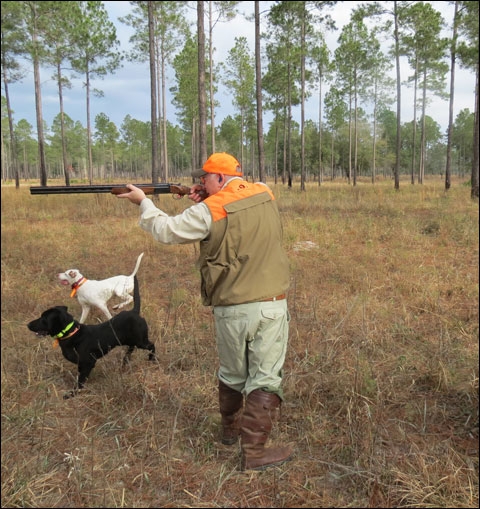
The late Robert Churchill’s book “Game Shooting” is legendary for introducing wingshooters to “instinctive shooting,” which forgoes any notions of measured forward allowance as you swing the shotgun to down your quarry.
“Dismiss all ideas of calculated allowances,” Mr. Churchill counseled.
Written with Macdonald Hastings and published in 1955, the book gave birth to the so-called Churchill Method for hunting game birds. It advocates relying on our innate eye-hand coordination, smooth swing and proper footwork. Mr. Churchill’s innovative approach also inspired the eponymous, quick-handling, side-by-side noted for its shorter 25-inch barrels and XXV Churchill rib.
As Mr. Hastings wrote, “The essence of Churchill’s method is that he taught his pupils to swing on to the bird; to trust the unerring ability of the eye to make the necessary forward allowance, and to leave it to the gun to do the rest.”
Employing the Churchill Method with a shotgun suggests that lead is subconscious and the shot is triggered just as target focus is intensified and the comb of the stock is firmly planted under your cheek bone.
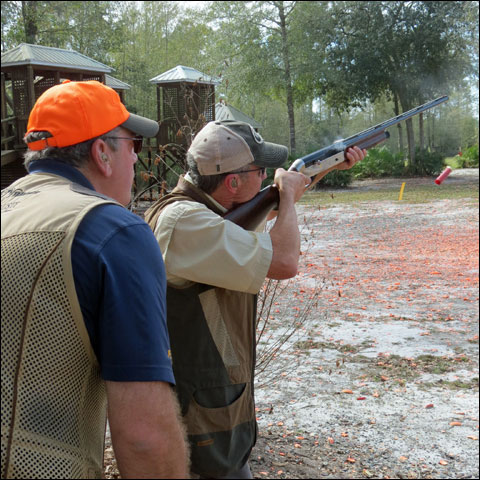 Don Currie (left) provides detailed instruction to Wingshooting Clinic participant, Stan Hill.
Don Currie (left) provides detailed instruction to Wingshooting Clinic participant, Stan Hill.
Mr. Churchill died in 1958, but the Churchill Method remains vibrant today. Several instructors and shooting schools have adopted it for their programs. Don Currie, though, has emerged as a leading campaigner through his published articles, his instructional DVD “Don Currie’s Focus-Movement-Faith, Instinctive Shotgunning for Sporting Clays” and personal shooting clinics. In effect, Mr. Currie has become an American Churchill of sorts from his base of operations at the Gilchrist Club in Trenton, Florida.
Although the “Sunshine State” contrasts with Mr. Churchill’s native English countryside, the wingshooting and sporting clays at The Gilchrist Club served as the setting for a clinic on the Churchill Method distilled by Mr. Currie through his own system called Focus, Movement, Faith. For those of us in attendance, Mr. Currie emphasized gun fit and eye dominance to attain unwavering target focus — the nucleus of the Churchill Method.
Mr. Currie is an NSCA Level III instructor, Associate of the Institute of Clay Target Instructors, former US Army Infantry School and Ranger School Instructor, Master Class sporting clays competitor and an NSCA National Delegate. He teaches at the Orvis Wing Shooting School and is an avid upland bird hunter.
He can cite chapter and verse from Mr. Churchill’s book. Still, when teaching Focus, Movement, Faith, Mr. Currie’s shorthand explanation on the Churchill Method is a baseball player catching an outfield fly by focusing exclusively on the ball and not the glove; so the focus of the sporting clays and wing shooter must be exclusively on the target. Hint: quit checking the barrels during the swing.
 One of the trails that cuts through the woodlands of the Gilchrist Club.
One of the trails that cuts through the woodlands of the Gilchrist Club.
We found time with Mr. Currie well-spent, but a bonus is visiting the Gilchrist Club. The private retreat is comprised of 27,000 acres of prime woodland in Northwest Florida. The land percolates with quail, turkey, deer, wild boar, alligator and trophy bass. It’s closed to the public — except when you’re booking lessons or clinics with Mr. Currie.
Our timing proved perfect. He was conducting a wingshooting clinic on the Gilchrist Club 14-station sporting clays course just when we were visiting the area. We jumped at the opportunity to book the two-day session, which would be followed by a day of guided bob white quail hunting.
Arriving late afternoon, we were buzzed through the imperial gates that swung open on stacked stone stanchions. The three-mile, tree-lined drive eventually opened to a cleared vista of five gorgeous log lodges with stone chimneys and covered porches situated on the shore of Lake Suwannee — one of five lakes scattered throughout the Gilchrist Club.
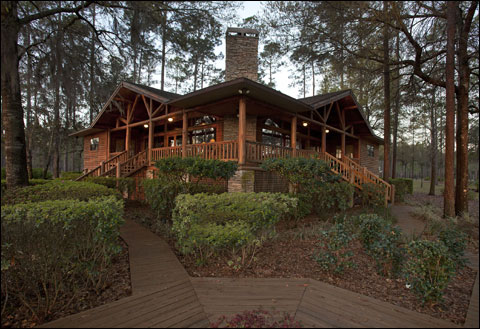 One of five lodges of the Gilchrist Club that provide views of Lake Suwannee.
One of five lodges of the Gilchrist Club that provide views of Lake Suwannee.
The land is actually a productive timber operation owned by Banker’s Insurance Group of St. Petersburg, Florida. With conservation top of mind, the very same experts also apply their know-how to cultivating the splendid bob white habitat that hugs the guest accommodations. Rest assured, you can tell these timber guys love to hunt.
Our four-bedroom lodge overlooked Lake Suwannee and the rustic patio that fronted the pro shop with its second-floor restaurant that featured picture windows. As we freshened up for dinner, caramel lamplight infused the wood-plank interior with the arrival of sunset. We hoped for a frosty night so we could stoke the large stone fireplace.
The white tablecloth dining room presented a gourmet dinner that we enjoyed with the lake view. The restaurant, where breakfast would be taken, served as the staging area for the whiteboard portion of our wingshooting clinic with Mr. Currie the following morning.
“We want to help you self-correct,” he started. “If you get to the point where you don’t need me anymore, I’ve done my job.”
The clinic’s curriculum for the Churchill Method would unfold through the stages of Focus, Movement, Faith.
Starting with Focus, Mr. Currie would instruct us on the finer points of eyeballing the target, dismissing perceptions of the barrel/target relationship and concentrating on a small portion of the entire target (front or back).
Movement would cover shot planning, the ready position and synchronizing our gun mount with the speed and line of the target.
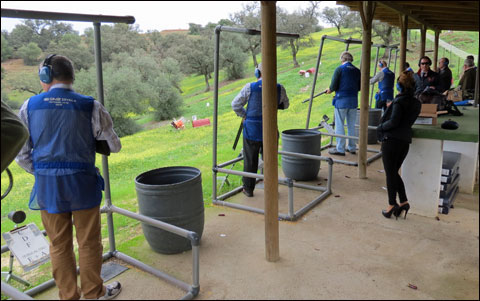 The 5-Stand at the Gilchrist Club served as a venue for Don Currie’s Wingshooting Clinic.
The 5-Stand at the Gilchrist Club served as a venue for Don Currie’s Wingshooting Clinic.
Faith emphasizes our natural eye-hand coordination (pulling the trigger at the moment target detail is perceived) and believing in our shot plan.
Eye dominance figured prominently with each of us being tested and our eye dominance status assessed. After all, he explained, “this sport is all about hand-eye coordination. You want your gun to fit so that it lines up with your dominant eye. The gun needs to shoot where you’re looking.”
Mr. Currie asserts that the eyes must lead while our hands should follow. He insists that most shots dropped by seasoned shooters occur in the last 2/10ths of a second right before the gun discharges: if our Faith or Trust falters during any point of the execution, our visual focus reverts to the barrel, with the result usually a missed bird.
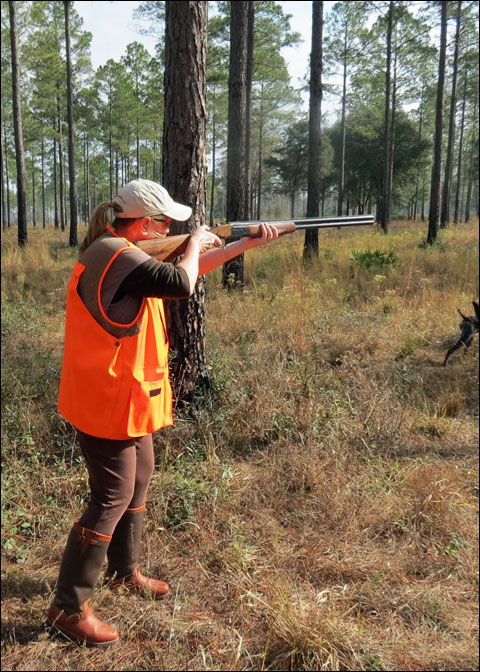 Shotgun Life Editor, Deborah McKown, tries out Perazzi’s MX20 on bob white quail at the Gilchrist Club.
Shotgun Life Editor, Deborah McKown, tries out Perazzi’s MX20 on bob white quail at the Gilchrist Club.
For the uninitiated, Focus, Movement, Faith emphasizes somewhat of a paradox. How do you shoot instinctively without thinking about it? Mr. Currie stresses that many wing and clay shooters tend to mount their shotguns prematurely, ride the target and obscure it with either too much barrel time or over-calculation.
My first-hand experience translated “instinctive” into “confidence.” If you possess confidence as a shooter (gain the ability to read targets and mount the shotgun with fluid ease) you have in effect mastered Churchill’s ideal of instinctive shooting. Instinctive is the way you drive a car. The more time behind the wheel, the better your reactions despite the diminishing intensity of conscious thought.
But confidence is acquired through greater, consistent success in breaking tougher targets. And Mr. Currie’s Wingshooting Clinic marks the beginning of that journey.
 A Gilchrist Club bird buggy.
A Gilchrist Club bird buggy.
Now on the sporting clays course, Mr. Currie tended to us individually — calculating our ability. His personalized attention tutored us on gun-mount mechanics and eye dominance. Throughout, his refrain was “not too much time in the gun,” meaning that we shouldn’t ride the target excessively once the shotgun reaches the cheek and shoulder. “The longer you’re in the gun, the greater the chances of a miss,” he would say.
To attain target fluency, Mr. Currie taught shot planning — the complete interpretation of the bird’s flight to ultimately spot the optimal break point along the line. Shot planning played into move/mount/synchronization; you should commit to the kill zone since the Churchill Method allows only a split second once the gun is mounted to execute the shot or risk having the targetdrop below the barrel where it will become eclipsed.
 The Perazzi MX20 after a day of wingshooting at the Gilchrist Club. While hunting bob white quail, a pheasant rooster flushed and was taken by Shotgun Life Publisher, Irwin Greenstein.
The Perazzi MX20 after a day of wingshooting at the Gilchrist Club. While hunting bob white quail, a pheasant rooster flushed and was taken by Shotgun Life Publisher, Irwin Greenstein.
At noon, we returned to the restaurant for lunch until 1:30, then drove to the Gilchrist Club five-stand. Mr. Currie emphasized that we should trust our “on-board computer” (subconscious) with the proviso that we mastered gun mount and resolved potential eye dominance glitches.
“See the target, cheek, bang,” he instructed.
“Prepare your body to receive the gun,” he advised. “The inefficiency of a sloppy mount pulls your eye from the target.”
Our first day concluded with an elegant dinner topped by a cigar on the lakefront patio around the blazing fire pit enriched with magnificent star gazing.
The next day, breakfast was followed by a session at the patterning board. Positioned at 16 yards, Mr. Currie fine-tuned our stocks and even took my shotgun to the workshop where he sanded a smidgeon from the adjustable comb. The remainder of day two passed on the sporting clays course with targets growing in difficulty.
 Irwin Greenstein wheels around for a covey rise with the Perazzi MX20.
Irwin Greenstein wheels around for a covey rise with the Perazzi MX20.
Personally, the Churchill Method had remained an elusive ideal. I’ve dabbled in it over the years but never felt I could pinpoint the timing until completing Mr. Currie’s clinic. I finished a better shooter but only now, several months later, can I recognize steady positive results as I continuously strive to master it on sporting clays. A refresher with him is top on my list.
Like Mr. Currie’s clinic, quail hunting over dogs at the Gilchrist Club was tremendously rewarding among the loblolly pines, saw-tooth grass, palmettos and white oaks — especially with a Perazzi MX20. At 7½ pounds, some folks may argue it’s a bit heavy for hunting over dogs. This is where the debate ensues of balance versus weight. The 20-gauge over/under sporting 29½-inch barrels demonstrated an uncanny proficiency to smooth out adrenaline-fueled swings toward flushing coveys punctuated by a spot-on, 3½-pound, mechanical-trigger pull.
In the vernacular of Mr. Currie “See the target, cheek, bang.”
Irwin Greenstein is the Publisher of Shotgun Life. You can reach him at contact@shotgunlife.com.
Useful resources:
The Gilchrist Club web site
Don Currie’s WebsiteDon Currie’s Focus-Movement-Faith, Instinctive Shotgunning for Sporting Clays DVD
The Perazzi web site

Irwin Greenstein is Publisher of Shotgun Life. Please send your comments to letters@shotgunlife.com.


Comments